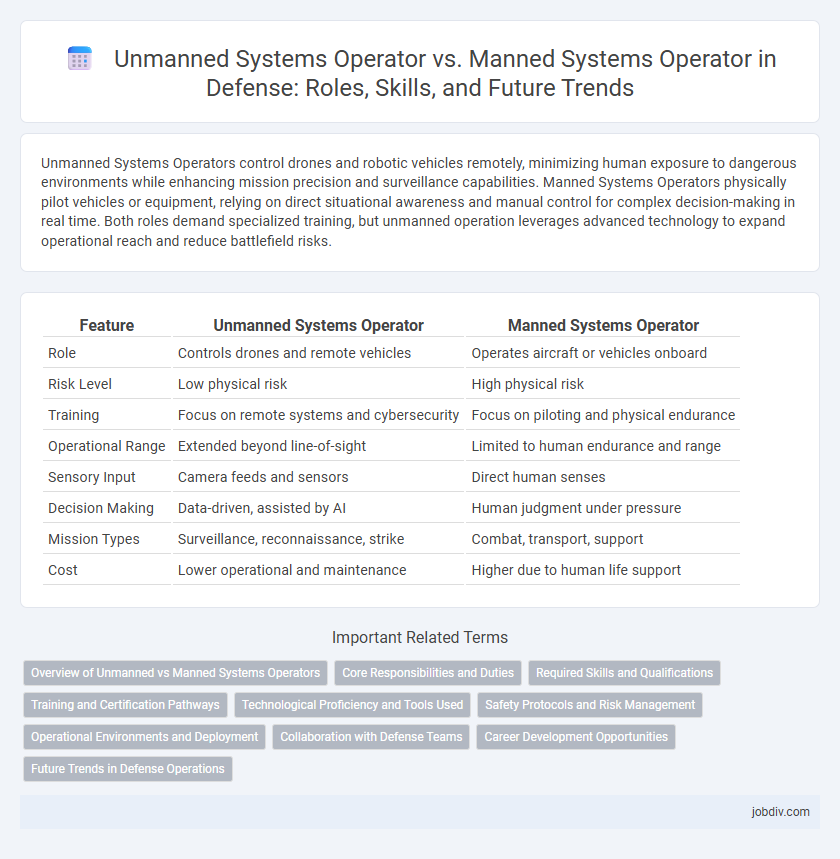Unmanned Systems Operators control drones and robotic vehicles remotely, minimizing human exposure to dangerous environments while enhancing mission precision and surveillance capabilities. Manned Systems Operators physically pilot vehicles or equipment, relying on direct situational awareness and manual control for complex decision-making in real time. Both roles demand specialized training, but unmanned operation leverages advanced technology to expand operational reach and reduce battlefield risks.
Table of Comparison
| Feature | Unmanned Systems Operator | Manned Systems Operator |
|---|---|---|
| Role | Controls drones and remote vehicles | Operates aircraft or vehicles onboard |
| Risk Level | Low physical risk | High physical risk |
| Training | Focus on remote systems and cybersecurity | Focus on piloting and physical endurance |
| Operational Range | Extended beyond line-of-sight | Limited to human endurance and range |
| Sensory Input | Camera feeds and sensors | Direct human senses |
| Decision Making | Data-driven, assisted by AI | Human judgment under pressure |
| Mission Types | Surveillance, reconnaissance, strike | Combat, transport, support |
| Cost | Lower operational and maintenance | Higher due to human life support |
Overview of Unmanned vs Manned Systems Operators
Unmanned Systems Operators control remotely piloted vehicles like drones, emphasizing real-time data analysis and mission adaptability without physical exposure to combat risks. Manned Systems Operators, operating traditional aircraft or vehicles, rely heavily on direct sensory input and human judgment in dynamic environments. The shift towards unmanned platforms reflects advancements in automation, sensor integration, and battlefield network connectivity, enhancing operational efficiency and reducing personnel vulnerability.
Core Responsibilities and Duties
Unmanned systems operators control and monitor remotely piloted vehicles and autonomous systems, ensuring mission accuracy and real-time data analysis, while maintaining communication links and system integrity. Manned systems operators pilot and navigate aircraft or vehicles directly, managing onboard systems and crew coordination during missions. Both roles require situational awareness, adherence to protocols, and effective decision-making under operational stress.
Required Skills and Qualifications
Unmanned Systems Operators require advanced technical skills in remote piloting, sensor management, and data analysis, often needing certifications in UAV operation and cybersecurity awareness. Manned Systems Operators demand strong physical stamina, situational awareness, and tactical decision-making capabilities, typically supported by rigorous flight training and military service experience. Both roles necessitate exceptional communication skills, but unmanned operators emphasize proficiency in software systems while manned operators focus on hands-on control and immediate environmental responsiveness.
Training and Certification Pathways
Training and certification pathways for unmanned systems operators emphasize specialized skills in remote piloting, sensor management, and cybersecurity, often requiring completion of FAA Part 107 certification or military-specific unmanned aircraft systems (UAS) qualifications. Manned systems operators undergo rigorous physical conditioning and flight training, incorporating pilot licensing such as FAA private or commercial pilot certificates, alongside mission-specific tactical instruction. Both pathways demand continuous skill validation through simulations and live exercises to maintain operational readiness and compliance with evolving defense standards.
Technological Proficiency and Tools Used
Unmanned Systems Operators rely heavily on advanced software interfaces, sensor fusion technologies, and remote control platforms to manage drones, robotics, and autonomous vehicles with precision. Manned Systems Operators utilize integrated cockpit systems, real-time tactile controls, and onboard instrumentation to perform navigation and weapon system tasks directly. Mastery of cybersecurity protocols and real-time data analytics distinguishes Unmanned Systems Operators, while situational awareness and manual dexterity remain critical for Manned Systems Operators.
Safety Protocols and Risk Management
Unmanned systems operators follow stringent safety protocols to mitigate risks associated with remote operation, including real-time monitoring and automated fail-safes that enhance mission safety. Unlike manned systems operators who rely on direct situational awareness and physical presence, unmanned operators prioritize cyber defense measures and loss-of-link procedures to prevent system compromise. Risk management for unmanned systems integrates advanced threat detection technologies and redundant control mechanisms, reducing human exposure to hazardous environments while maintaining operational effectiveness.
Operational Environments and Deployment
Unmanned systems operators manage remotely piloted vehicles in complex environments such as urban, maritime, and hostile territories, enabling missions without direct exposure to battlefield risks. Manned systems operators navigate vehicles like tanks, aircraft, and naval vessels, requiring physical presence that limits deployment in highly contested or hazardous zones. Deployment of unmanned systems offers extended endurance, real-time data collection, and stealth capabilities, while manned systems provide immediate decision-making and situational awareness in dynamic combat scenarios.
Collaboration with Defense Teams
Unmanned systems operators coordinate closely with manned systems operators to enhance situational awareness and real-time decision-making on the battlefield. Integrating autonomous vehicle data with pilot and ground crew inputs creates a comprehensive operational picture that improves mission success rates. This collaboration reduces risks to human personnel by enabling remote engagement and support in high-threat environments.
Career Development Opportunities
Unmanned Systems Operators benefit from expanding career opportunities as defense technology shifts toward autonomous and remotely piloted platforms, requiring advanced skills in software, data analysis, and systems integration. Manned Systems Operators maintain essential roles with career growth in leadership, tactical expertise, and complex mission execution that leverage human judgment and experience. Transition programs and cross-training initiatives increasingly enable operators to broaden skillsets, enhancing versatility and long-term career advancement within evolving defense operations.
Future Trends in Defense Operations
Future defense operations increasingly rely on unmanned systems operators who leverage advanced artificial intelligence, remote control technologies, and autonomous capabilities to conduct reconnaissance, surveillance, and precision strikes with enhanced safety and operational efficiency. Manned systems operators will continue playing vital roles in complex decision-making and mission adaptability, but hybrid integration of human oversight and unmanned system autonomy is projected to dominate battlefield dynamics. Emerging trends emphasize network-centric warfare, where seamless communication between unmanned platforms and manned command centers improves situational awareness and force projection.
Unmanned Systems Operator vs Manned Systems Operator Infographic

 jobdiv.com
jobdiv.com